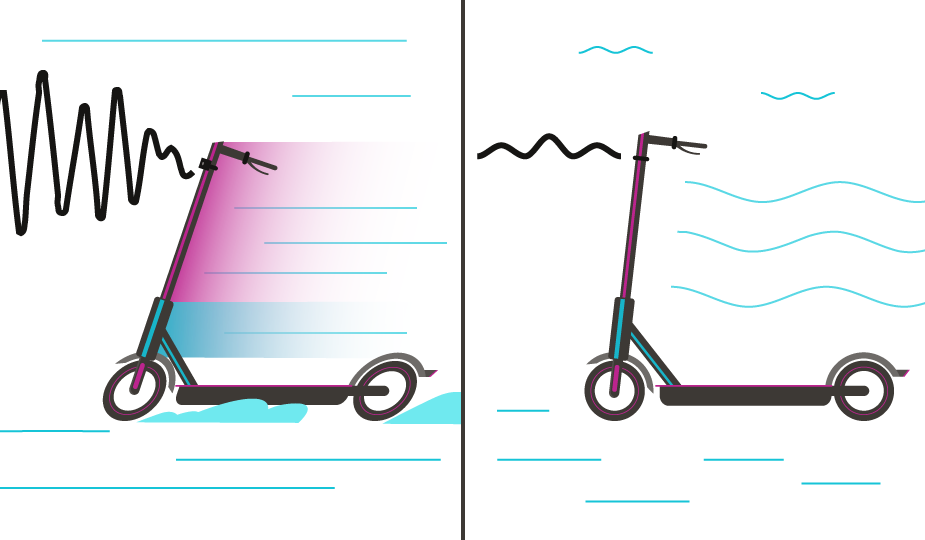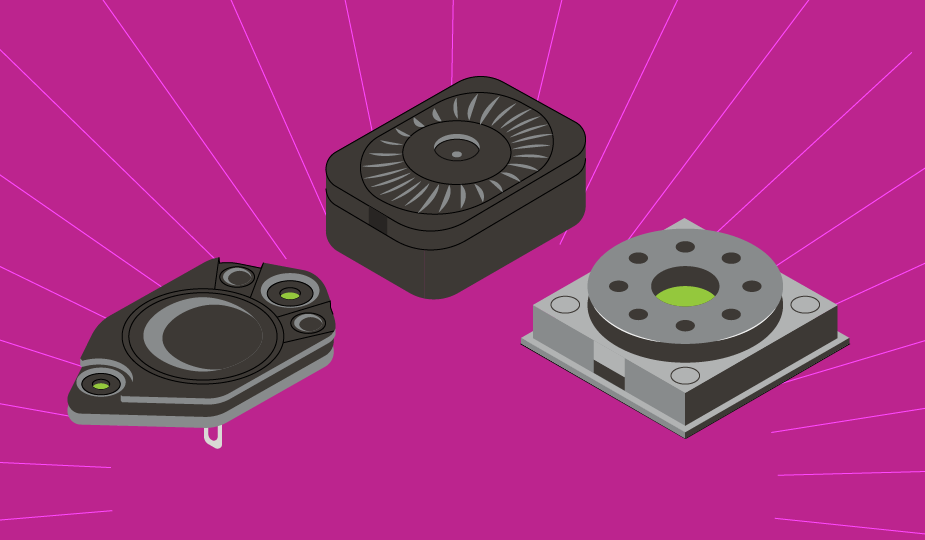Designing Reliable Audio Systems for Electric Two-Wheelers and Three-Wheelers

In today’s economic and environmental landscape, lowering costs and increasing efficiency are priorities for most businesses and individuals. In transportation, the lower upfront and operating costs of electric two-wheelers and three-wheelers have made them a popular alternative to electric vehicles or even their internal combustion predecessors. Their unique format also brings unique challenges and opportunities. Due to the open-air design, nearly silent operation, lower weight limits, and smaller cross-sections, the audio systems that are integrated into these vehicles have become increasingly important.
Importance of Audio in Electric Vehicles
Correctly done, most audio systems are second nature to the users that interact with them and feel like a natural extension of a vehicle, yet this does not diminish their importance. Safety requirements that protect both the operator and pedestrians need to be considered. With electric motors and generally smaller tires, the operating noise of these vehicles is minimal, and pedestrian alert systems need to be created to notify nearby pedestrians of the fact that a vehicle is operating in the area. This problem is exacerbated at lower speeds when the electric motor whine is minimal and even the tire noise is practically non-existent. Specific audio alerts help operators and pedestrians be better aware of each other and avoid collisions.
In addition to safety requirements, there are many audio alerts used to notify the driver of the current vehicle status. Updates of the vehicle condition, particularly battery life, need to be urgent yet not alarming, while onboard GPS navigation needs to be clear and understandable without being overwhelming. As discussed in our Basics of Ultrasonic Sensors blog, ultrasonic sensors are often used with vehicles, including larger three-wheelers as proximity alarms. Most car drivers are familiar with the increasing urgency of audio alarms as they get closer to a potential hazard. Finally, due to their inherently smaller size, theft of two- and three-wheeler vehicles is a concern, and a loud, piercing audio alarm should be considered. Piezo or magnetic buzzers could be used with these alarm systems, depending on the desired audio volume, size, usage flexibility, and power requirements. You can learn more about the differences between these technologies in our Buzzer Basics blog post. Speakers are also an option and offer the greatest variability in what sounds can be output from the same source, at the expense of more challenging drivers and more demanding power.
Of course, these examples are not just good design for new vehicles; many of them fall under international regulations. For example, UNECE R138 is a regulation created by the United Nations stating that from 2019 forward, all new electric vehicles, including two- and three-wheelers, that are not loud enough in their normal operation must install sound alert devices. This regulation, and others, can help guide and ease the design process. Failure to follow those regulations, however, will strongly affect the ability of car designers and manufacturers to market their vehicles in different countries.
Key Audio Design Considerations for Electric Vehicles
In the design process, once the requirements have been laid out, there are considerations unique to these types of vehicles that must be accounted for. In most cases, these vehicles are completely open to the elements. Rain, snow, dust, and mud can affect the audio equipment in ways that would never be expected with typically enclosed cars. This is on top of the typical challenges of vibration and unintentional or intentional driver abuse that every vehicle faces. At Same Sky, we offer waterproof audio solutions. Utilizing IP rated options and performing thorough testing are excellent ways to make sure that audio components survive the worst of weather-related concerns.

While durability is essential, an audio system that survives the elements yet does not meet the audio design requirements is unacceptable. With the open environment, ambient noise is allowed in, and internal speakers must be actively controlled to focus on the driver in order to achieve sufficient clarity at reasonable volumes. Systems that intelligently adapt to the acoustic environment, either due to ambient noise or changing road noise, can provide an edge in the quality of the audio. In enclosed vehicle systems, there has been experimentation with active noise cancellation. This is something that would be extremely difficult to do with an open-air two- or three-wheeler but is an excellent example of out-of-the-box thinking that can be focused on improving the audio quality of different vehicles.
As mentioned earlier, besides being open-air, these vehicles are much smaller and lighter. While selecting the audio equipment, it needs to be compact to fit in the limited dash or control space. Even when mounted out of sight, there is simply less room in these vehicles than even the smallest four-wheel vehicles commercially available today. Combining the fact that these audio systems are interconnected with many aspects of the vehicle, such as the ECU (for monitoring battery status and more), navigation systems, and mobile devices, and also need to offer Bluetooth or other wireless protocols, the space restrictions become even more pressing. Of course, in no way is this an impossible task, simply one that requires a tighter focus on space and weight savings. Same Sky’s micro buzzers and micro speakers can help to address space-constrained designs.
While not all of these types of vehicles are designed for offroad use, many of them face rougher-than-usual surfaces in their lifetimes. These rugged terrains will cause the lightweight frames to twist and move while the smaller suspension systems will often transfer more structural vibrations from the chassis to anything mounted on the vehicle. With properly selected equipment that can withstand a certain level of vibrations, the next step will be to use proper mounting practices to ensure that the equipment never feels any forces outside of its rating. Vibration isolation materials mixed with secure mounting will make certain that the equipment is protected. Of course, the exact details of the best methods will be dependent on what is being used, and the manufacturer will have specific recommendations. Read our Speaker Mounting Guidelines blog post for best practices.
Practical Tips for Design Engineers and Emerging Innovations
Mounting, integration, and implementation will only get a design engineer so far before passing the point of being unable to get any more out of the equipment. Thus, it is essential to choose the right components for the application, both in terms of functionality and quality. The best components are also those that are supported by their manufacturers, providing specialized insights and design help, sharing their years of experience with their products. Manufacturers, such as Same Sky, that go beyond a transactional relationship and offer audio design services from the design stages all the way to the end-of-life of a product can make the difference between success and failure.
Electric vehicles, whether open to the air or not, have unique challenges not faced by internal combustion engines. As the audio system is tied in with the overall electronics and is held in close proximity to both electronics and motors that generate significant EMI, interference becomes a tangible and audible problem. A variety of ways to mitigate this interference, be it shielded cabling, different wire routing paths, or greater distance between EMI generators and components susceptible to that EMI, can be used to best fit the situation. A separate but related problem of all power coming from the same source also needs to be addressed for both the drivetrain and electronics. When going uphill, even at the same speed, the motors will increase their current demand, potentially causing a voltage drop on the overall system even with the usage of voltage regulators. More aggressive load compensation regulators may be required to make sure there is not any form of audio distortion as the load changes.

New technology may not always make a design engineer’s life easier; it is often the opposite. However, advanced speaker and microphone technologies often yield smaller, more efficient, and more effective components that may work in more extreme environments. On the software side, AI has become pervasive and can be used on a small scale, even in these vehicles. Adaptive sound systems that adjust volume based on ambient noise already exist and the use of a more robust logic system may expand to not only adjust the volume but even modify the equalizer – boosting those frequencies that will best cut through the background.
As always, the best simulations and theories should still be checked against actual user feedback during the different design iterations. Sometimes, there are exceptions to the rules that need to be discovered, and other times there are unintentional deviations from the rules that were not noticed during design. Either way, it is the human experience that will dictate how well the vehicle operates and, ultimately, sells.
Conclusion
There are many important aspects of creating a successful vehicle and this is just as true with electric two-wheelers and three-wheelers. Audio is one of these but, fortunately, the path to success is clear. Design engineers need to identify the unique requirements of the audio systems, such as their open-air nature, the increased security concerns, and the weight and size constraints. With these ideas in mind and looking forward to an ever more innovative and sustainable future of audio solutions in the EV market, engineers and developers across the world can set the tone for the next generation of vehicles. Same Sky’s range of audio components as well as audio design services are here to help!




